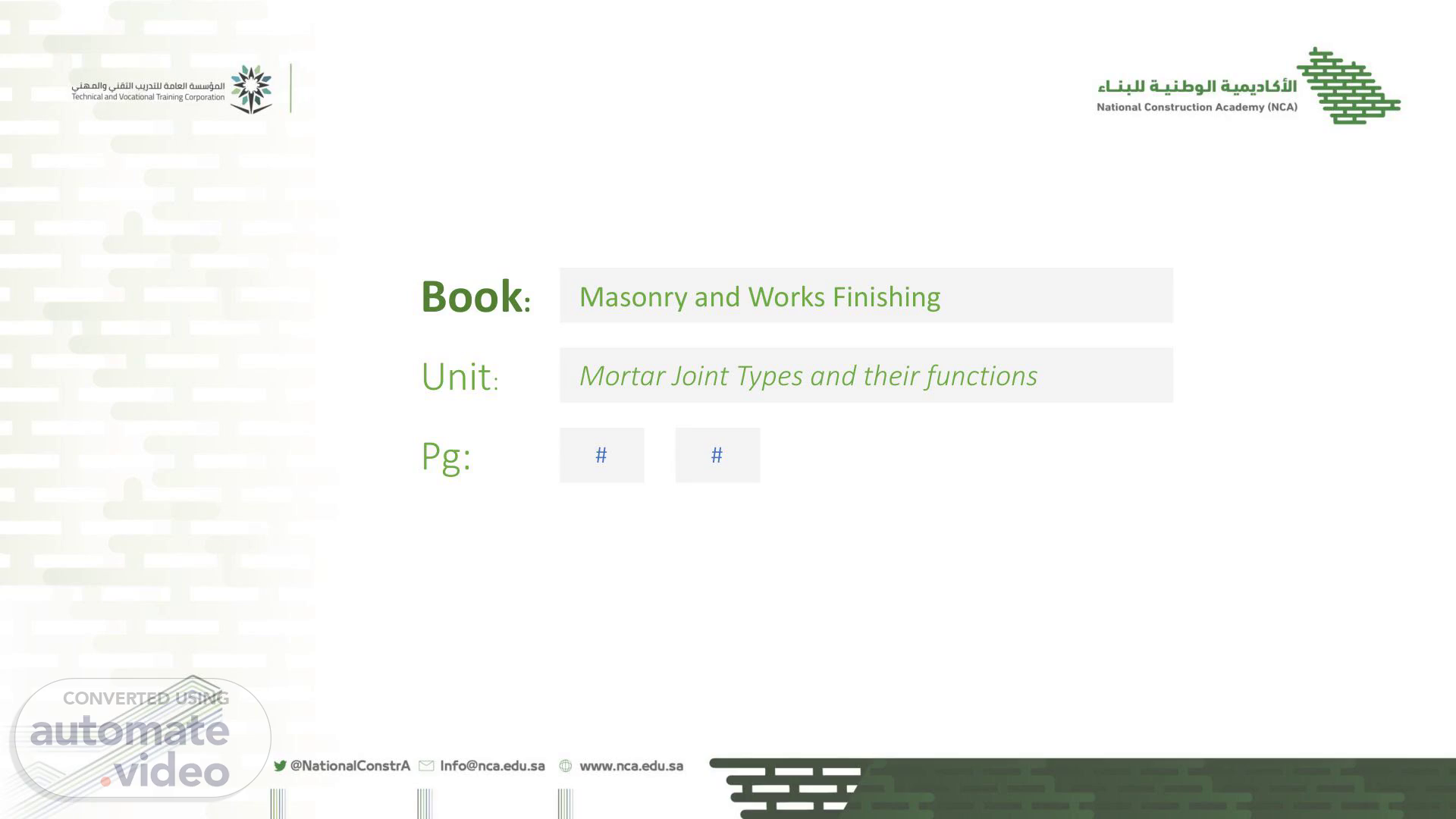Scene 1 (0s)
[Audio] Masonry and Works Finishing Book: Mortar Joint Types and their functions Unit: # # Pg:.
Scene 2 (8s)
[Audio] Introduction Mortar joints are the spaces between bricks or stones filled with a mixture of cement, sand, and water, providing structural integrity and weatherproofing to walls..
Scene 3 (21s)
[Audio] Objectives Common mortar joint types : concave , flush , and weathered Significance of jointing in wall strength and durability https://www.youtube.com/watch?v=dSgn-SCulEk.
Scene 4 (39s)
[Audio] Key terms Mortar Joints: Spaces found amongst bricks or stones, filled with a mixture of cement, sand, and water, providing structural integrity and weatherproofing Weathered Pointing: A technique where mortar is pressed into a joint, and the top portion of the horizontal joints is pressed back by 3-6 millimeters, creating a sloped effect that gives the appearance of weathered or worndown edges Aesthetics : a pleasing appearance or effect : beauty.
Scene 5 (1m 10s)
[Audio] Mortar Joint Types and their functions What are Mortar Joints? Mortar joints are the spaces found amongst bricks or stones, filled with a special mixture of mortar that generally contains cement, sand, and water. Mortar works to join bricks, stones, or other building blocks together, in turn keeping the wall together with well-dispersed stability. Advantages of pointing in construction : 1) Enhances structural integrity, ensuring a stronger building. 2) Provides weatherproofing, protecting external walls from moisture. 3) Restores the overall appearance of the building, improving its aesthetics. 4) Increases the value of your property, making it more desirable. 5) Reduces ongoing maintenance needs, saving time and costs.
Scene 6 (2m 6s)
[Audio] Common mortar joint types Concave mortar joints : The shape of these mortar joints might resemble a small dip or even a bowl. This type of design serves well to direct rainwater off the wall and thus reduces the chance of water damage. Due to the concave type of design, which is so practical for protection yet seems very neat to the eye, this is one of the most commonly used mortar joints for many kinds of masonry work.
Scene 7 (2m 34s)
[Audio] Common mortar joint types Flush Mortar Joints : Flush mortar joints, as the name suggests, are flush or in line with the masonry surface. This joint looks relatively smooth, flat and modern. Even though it does not perform as well in terms of keeping water out as compared to the concave, many builders still prefer using them because they give wall surfaces a clean and refreshing appearance ..
Scene 8 (3m 0s)
[Audio] Common mortar joint types Weathered Pointing : Weathered pointing is a technique where mortar is pressed into a joint, and while the mortar is still fresh, the top portion of the horizontal joints is skillfully pressed back by 3-6 millimeters using a pointing tool. This creates a distinctive sloping effect from the top of the joint to the bottom, giving the appearance of weathered or worn-down edges.
Scene 9 (3m 25s)
[Audio] Question What are the common types of mortar joints ? What is the function of concave mortar joints ? What is the purpose of mortar in construction ?.
Scene 10 (3m 35s)
[Audio] Key point Mortar joints are spaces between bricks or stones filled with a cement, sand, and water mixture, providing structural integrity and weatherproofing. Mortar works to join bricks, stones, or other building blocks together, in turn keeping the wall together with well-dispersed stability. The most common types of mortar joint is Concave, Weathered, and flush.
Scene 11 (3m 59s)
[Audio] Summary Mortar joints are spaces between bricks or stones filled with a cement, sand, and water mixture, providing structural integrity and weatherproofing. Common types include concave joints, which effectively direct rainwater away; flush joints, which offer a smooth look but less water protection; and weathered pointing, which creates a sloped effect. Proper pointing enhances structural integrity, aesthetics, property value, and reduces maintenance..
